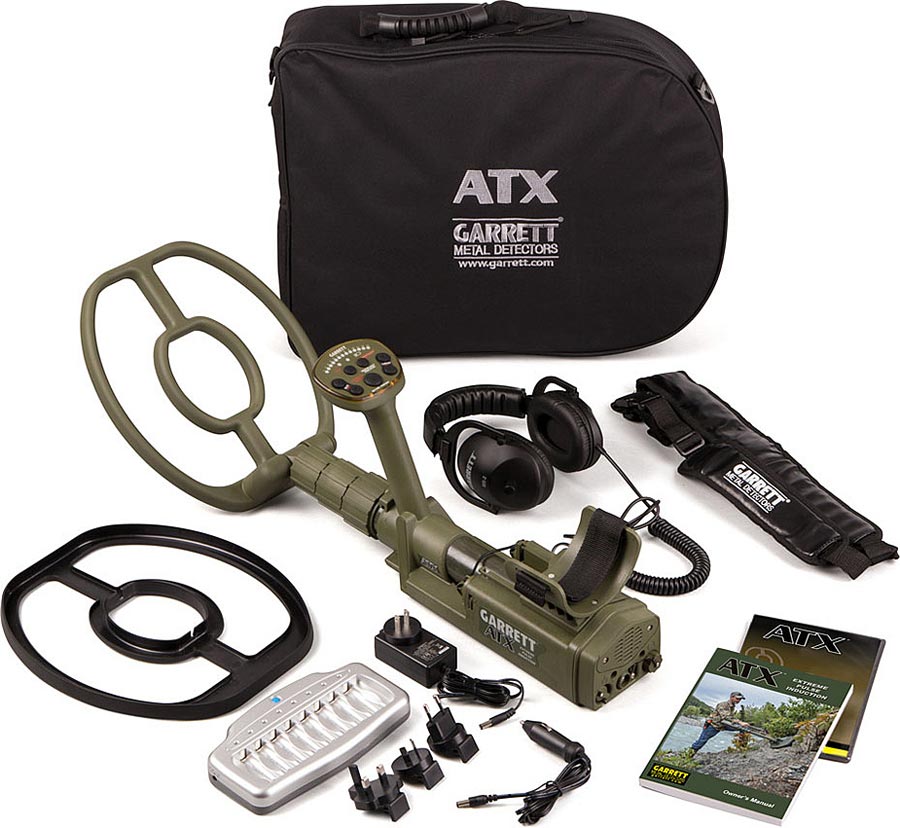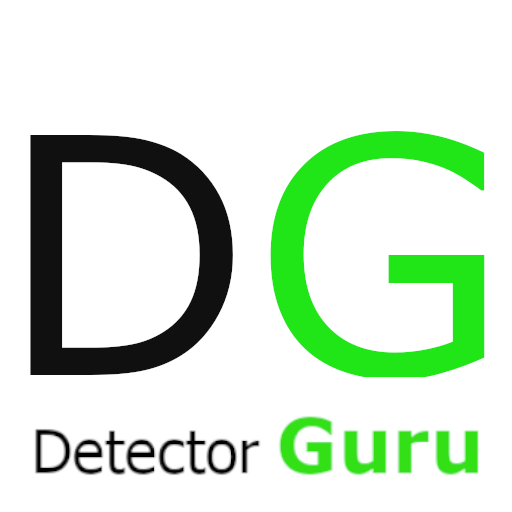
The Garrett ATX pulse induction metal detector is a gold detector for the consumer market, released in 2013. Garrett has said that the ATX meets military specifications, one would assume so as the mechanical platform looks to be based on Garretts military Recon PRO countermine detector.
Being a pulse induction detector it’s at home in heavily mineralized ground, so the ATX is ideal for prospectors for gold, beach combers and even relic hunters.
Build
As with what you would expect with anything that is built to military specification, the ATX is built tough. The khaki green really drives home the tough and rugged appearance.
What’s great about the ATX is that it’s foldable and still remains submersible. When collapsed it measures in at 19.9” or 505mm, which helps it fit nicely in its provided travel case. Excluding batteries and headphones the ATX weighs in at 6.3 lbs or 2.9 kg, so it’s no lightweight, but again this is a rugged detector so the extra weight isn’t surprising.
The inbuilt external speaker allows you to detect without headphones if you choose to, the speaker is located in the rear of the detector and is easily heard. The supplied headphones are of a good quality and are quite comfortable to wear for extended periods, there is a nifty place to stow your headphone connector cap to stop it bounce around. The headphone connector style requires your full attention when connecting or you will run the risk of damaging it.
Nothing makes a detector look cleaner than a shaft that keeps the coil cable neatly hidden inside, although the shaft is made of plastic it does the job without fault. The handle feels solid and the overall feel is that of a sturdy, well built detector. People with big fingers might have a bit of difficulty replacing the coil due to the confined area the connector is housed.
Features
Detector technology: Pulse induction metal detector
Controls: controls are located on the handle, there is a LED signal strength display, shift function LED and power on LED. It also houses the buttons for the primary and secondary controls. The on/off switch is on the back of the electronics housing, under the external speaker.
Audio Threshold: this brings up the background ‘hum’ level, good in noisy conditions such as windy days at the beach.
Ground balance: The Fast Track ground balance on the ATX has the ability to eliminate noisy ground types by selecting ground balance over a target free piece of ground and raising and lowering the coil until the sound of the ground goes away.
Ground Track: this is an automatic feature where the ATX monitors ground mineralization and makes adjustments to itself to ensure best performance.
Search mode: motion, non-motion modes and pin point. Motion mode requires the coil to be moving to pick up targets whereas non-motion can be held steadily over targets as with pin point mode.
Submersible: the ATX is submersible to 10 feet or 3m, just remember the headphones that come with the detector are not waterproof.
Warranty: For your peace of mind Garrett backs the ATX with a 2 year, limited parts/labor warranty.
Sensitivity: there are 13 levels for sensitivity. This can be adjusted if the unit is acting erratically but doing a frequency scan or ground balance hasn’t solved the issue.
Discrimination: Controlled with the push of a button, the user has a choice of 25 settings to discriminate against unwanted targets. Giving you the ability to ignore pull tabs and the small trash items, just be careful not to discriminate against wanted items.
Frequency scan: searches for finds the quietest operating frequency available. Once it has found the best frequency it then gets stored to memory and will remain there even on power off.
Coils
Users are somewhat spoilt for choice if they choose to purchase additional coils, there’s coils galore for the Garrett ATX. There are also Deepseeker packages available to those that want to purchase their detector along with an additional coil.
Mono coils:
- 15” x 20” (38cm x 50cm) Deepseeker mono coil (open)
- 8” (20cm) Mono coil (open)
- 11” x 13” (29.9cm x 33cm) Deepseeker mono coil (closed)
DD coils:
10” x 12” (25cm x 31cm) DD coil (open)
11” x 13” (29.9cm x 33cm) DD coil (closed)
Performance
It is a bit on the heavy side, at times it can seem heavier than its reported weight, this might be due too ergonomics. The ATX really requires you to set up the shaft and coil angle correctly to your height.
Easily change shaft length and coil angle and it will still work the same as fully extended, this means you can search the hardest to reach areas without compromise.
User controls do take a little while to become familiar with, you will need to spend some time becoming familiar with them. On your first few out outings with the ATX, its advised to keep the user guide close by. The controls have a good feel to them, but some users might find the display a bit on the cluttered side. The signal strength strength LED display works well and gives a good visual indicator for your targets.
Having a volume control that limits sound on large targets so your ears don’t get blown off your head if you find a large piece of Iron is a great idea, thankfully this doesn’t limit sound on small targets.
There are two search modes on the ATX, being motion mode and non-motion mode. When using motion mode it helps to reduce noise from highly mineralized ground, as the name suggests, the coil must be kept in motion to detect targets. Motion mode gives you an echo tone along with a high or low tone. Poor conductors like small nuggets, jewellery and small brass or nickel coins make a hight tone with a low tone echo. Good conductors such as large nuggets, copper and silver coins have a low tone with high tone echo. In most cases iron will give a low tone with high tone echo.
In non motion mode the detector may become less stable and noisy, but can give more depth detection and allow the user to scan much slower with out having to keep the coil in motion to detect a target. Poor conductor targets will give a high tone but no echo tone and good conductors will give a low tone but no echo. Non motion mode leaves the tuning to the user so it’s not recommended to inexperienced users.
The ATX takes 8 AA batteries (one pack of four per side) located under the armrest, which is pretty handy if you ever forget your charger and need to use alkaline batteries. Battery life is good and should last a day of detecting, some users reporting 8 to 10hrs. It’s always a good idea to have multiple sets when detecting in secluded areas.
Conclusion
What makes the Garrett ATX a great detector is its usability in salt water and on sand or even black sand for that matter, users have really taken a liking to this detector for these reasons. Finding gold also isn’t a problem for the ATX, but probably not what it’s best at.
Unlike the Minelab SDC2300, the Garrett ATX isn’t aimed towards the beginner. You won’t be able to hand the ATX to Grandma or the kids and have them happily detect away, it does take time to learn the controls and how to get the best performance out of it. Spending time reading the user guide, watching Garrett’s videos and even having a play in your yard will certainly reduce the learning curve.
The weight for some users has really become a deal breaker, so if you have bad shoulders or just generally have some weakness in your arms, it might be worth trying to borrow or hire one to see if it suits you.
If you want a very capable PI detector that is waterproof, able to change coils, rugged and well priced, the Garrett ATX might be the one for you.






